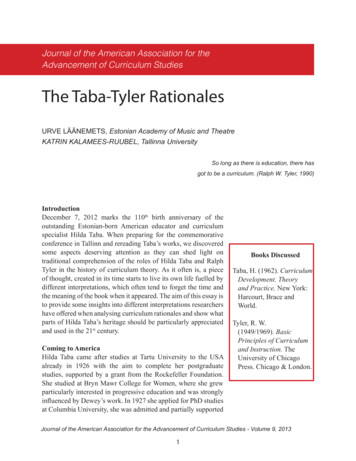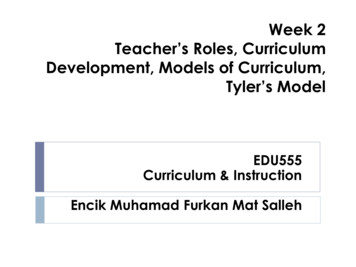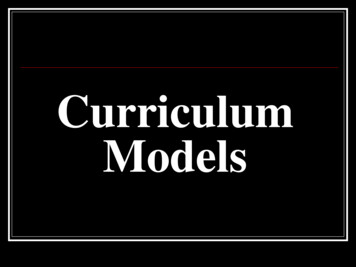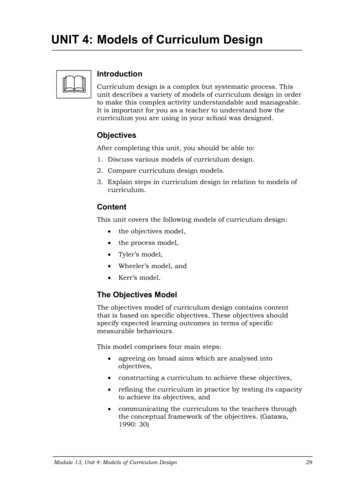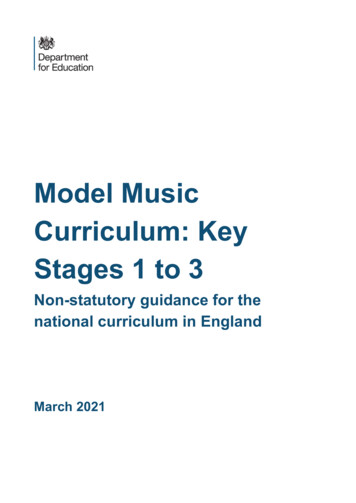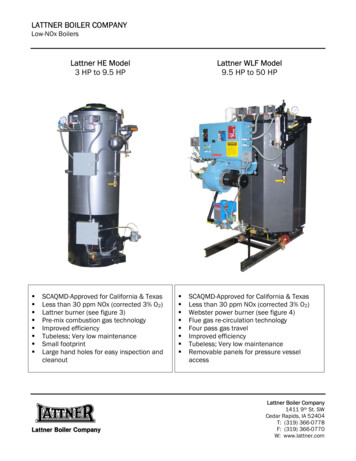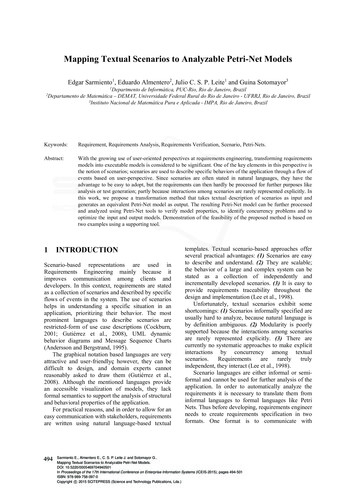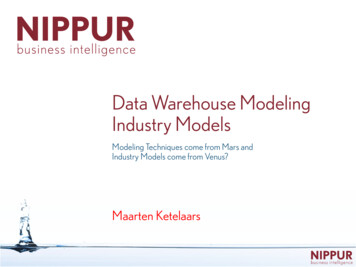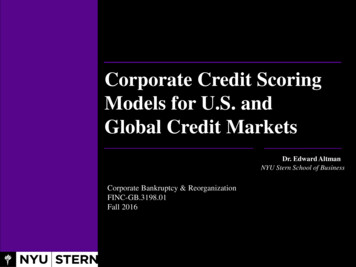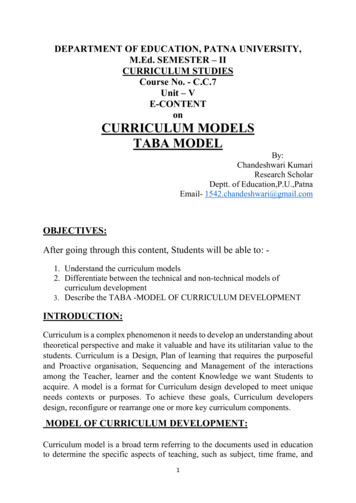
Transcription
DEPARTMENT OF EDUCATION, PATNA UNIVERSITY,M.Ed. SEMESTER – IICURRICULUM STUDIESCourse No. - C.C.7Unit – VE-CONTENTonCURRICULUM MODELSTABA MODELBy:Chandeshwari KumariResearch ScholarDeptt. of Education,P.U.,PatnaEmail- 1542.chandeshwari@gmail.comOBJECTIVES:After going through this content, Students will be able to: 1. Understand the curriculum models2. Differentiate between the technical and non-technical models ofcurriculum development3. Describe the TABA -MODEL OF CURRICULUM DEVELOPMENTINTRODUCTION:Curriculum is a complex phenomenon it needs to develop an understanding abouttheoretical perspective and make it valuable and have its utilitarian value to thestudents. Curriculum is a Design, Plan of learning that requires the purposefuland Proactive organisation, Sequencing and Management of the interactionsamong the Teacher, learner and the content Knowledge we want Students toacquire. A model is a format for Curriculum design developed to meet uniqueneeds contexts or purposes. To achieve these goals, Curriculum developersdesign, reconfigure or rearrange one or more key curriculum components.MODEL OF CURRICULUM DEVELOPMENT:Curriculum model is a broad term referring to the documents used in educationto determine the specific aspects of teaching, such as subject, time frame, and1
manner of instruction. A Curriculum model determines the type of curriculumused it encompasses educational philosophy, approach to teaching, andmethodology. The success of our educational endeavours rests on carefulplanning, without which disorder and chaos will result. The need to plan effectivecurricula cannot be denied. From such curriculum makers plans a model forcurriculum development. For the construction of a curriculum, thought should begiven to goals, content, learning experiences, methodology and evaluation.Curricular approaches also focus on different aspects like subject matter andsociety.Models can be classified as either technical or scientific models and non-technicalor non-scientific modelsTechnical or scientific models –Educators who emphasize subject, matter approaches adopt the scientific ortechnical approach for the curriculum development. Curriculum developersdesigned this approach by using the scientific model which requires observingand monitoring of components. These components are subject matters,objectives, learning experiences and evaluation. In this approach curriculumdevelopment is a useful BluePrint for structuring the learning environment.Technical or scientific models as follows:1. Hilda Taba Model2. Tyler Model3. Saylor Alexander Model4. Goodlad Model5. Hunkins Model6. Miller and Seller ModelNon-technical or non-scientific –Educators who emphasize learners and problems formulate non-technical ornon-scientific curriculum designs. It has been described as Subjective, Personal,Aesthetic and focuses on learner needs and subject matter and society, becomesecondary.Three models under this category:1. Open Classroom Model2. Wienstien and Fantini Model3. Roger's Model of Interpersonal Relations2
Hilda Taba Model of Curriculum developmentHilda Taba (7 December 1902 – 6 July 1967)About Hilda Taba: Hilda Taba was an architect, a curriculum theorist, a curriculum reformer,and a teacher educator. She was born in the small village of Kooraste, Estonia. Her mother’s name was Liisa leht and her father Robert Taba was aschoolmaster. She wrote many books especially in education-The Dynamic of Education(1932), Adolescent Character and personality (1949), School Culture:Studies of Participation and leadership(1955), Action Research: A casestudy(1957), Curriculum development and practise (1962), Thinking inElementary School Children(1964) etc. Taba contributed to the theoretical and pedagogical foundation of conceptdevelopment and critical thinking in social studies curriculum and helpedto lay the foundation of education. Taba created a multipurpose teaching model that utilizes the use of multipleprocess i.e. Listing, grouping, re-grouping, labelling, and synthesising. Hermodel “Grassroot approach” is modified version of Tyler's model.Taba’s opinion about Curriculum:Taba Defines ‘curriculum’ as containing a statement of the aims and of thespecific objectives; it indicates some selection and organisation of content; iteither implies or manifests certain patters of learning and teaching .Because the3
objective demand or the content organisation requires it includes a program ofevaluation of the outcomes.Taba’s Philosophical ideas on Curriculum Development:At least four principles that seems to govern her vision of curriculum theory andcurriculum development were:1. Social processes, including the socialization of human beings, are notlinear, and they cannot be modelled through linear planning. In otherwords, learning and development of personality cannot be considered asone-way processes of establishing educational aims and deriving specificobjectives from an ideal of education proclaimed or imagined by someauthority.2. The reconstruction of curricula and programmes is not a short- term effortbut a long process, lasting for years.3. Social institutions, among them school curricula and programme is moreeffectively rearranged if, instead of the common way of administrativereorganisation-from top to bottom- a well -founded and co-ordinatedsystem of development from bottom to top can be used.4. The development of new curricula and programmes is more effective it isbased on the principles of democratic guidance and on the well-foundeddistribution of work. The emphasis is on the partnership based oncompetence, and not on administration.Taba’s Model of curriculum Development:Hilda Taba is the developer of this model of learning. Taba believed that therehas a definite order in creating a curriculum. This model is used to enhance thethinking skills of students. She believed that teachers are aware of the student’sneeds. Hence, they should create specific teaching-learning situations for theirstudents. They should adopt an inductive approach to teaching i.e. from specificto general rather than the traditional deductive approach, starting from generaland building to the specifics. Taba promotes the “Down-Top model” or Grassrootapproach. Taba argued that curriculum development should follow a sequentialand logical process and she suggested for more information input in all phases ofcurriculum development. she also claimed that all curricula are composed offundamental elements. The main idea of this model is that the students are at thefore front to the curriculum. She believed that there must be a process forevaluating student achievement of content after the content standards have beenestablished and implemented. The main concept of this model is that teacher mustbe involved in the curriculum development. Tabs's grassroot model has sevensteps as listed below, advocating a major role for teachers.4
STEPS OF HILDA TABA MODEL1.Diagnosis of learners need2. Formulation of Objectives3. Selection of Content4. Organisation of content5. Selection of learning experiences6. Organization of learning activities7. Evaluation5
1. Diagnosis of learners need: The teacher who is also the curriculum designer starts the process byidentifying the needs of the students for whom curriculum is to be planned.For example: Majority of students are unable to think critically.2. Formulation of Objectives: After the teacher has identified the needs of learner that require attention, heor she Specify the objectives by which needs will be fulfilled.3. Selection of Content: The objective selected or created suggest the subject matter or content of thecurriculum. Not only objectives and content should match, but also the validityand significance of the chosen content needs to be determined. i.e. therelevancy and significance of the content.4. Organisation of content: A teacher cannot just select content but must organise it in a ParticularSequence taking into consideration the maturity of learners, their academicachievement and their interests.5. Selection of learning experiences: Content must be presented to students and they must be engaged with thecontent. At this point teacher should select appropriate instructionalmethodology that will involve the students with the content.6. Organization of learning activities: The learning activities be organized in a sequence depending both on contentsequence and learner characteristics. The teacher needs to keep in mind thestudent he or she will be teaching.7. Evaluation: The curriculum planner must determine that what objectives have beenaccomplished. To assess the achievement of learning objectives, evaluationprocedures need to be designed.BENEFITS OF USING THE TABA MODEL:1. This model taps into higher- order thinking skills.2. Builds comprehension skills such as inference, synthesizing andsummarizing.3. Gifted learners will thrive with the opportunities to explore questions withmultiple correct answers.6
4. Questioning is open ended, No clear right or wrong response.5. When grouped together students work collaboratively with others to buildskills with speaking and listening’6. Provides an opportunity for healthy classroom discussions before and aftergeneralizations are made.LIMITATIONS OF USING THE TABA MODEL:1. Can be difficult for some students to handle the open- ended aspect of themodel.2. Without clear direction it may be difficult for teachers, to plan and preparequestions for the path of the students take.3. Difficult to adapt for all subjects, and even some types of texts.4. Texts most be chosen in advance.APPLICATION OF THE TABA MODEL:Taba model is currently used in most curriculum designs. Identifying the needs of the students.Developing objectives.Selecting instructional method.Organising learning experiences.Evaluate your progress: Describe the Grassroot Approach of Hilda Taba. Write the seven steps of Taba Model.Reference:1. Murunalini, T. (2007): Curriculum Development, 1st Ed., NeelkamalPublications Pvt. Ltd., Sultan Bazar Hyderabad- 500095.2. Hilda Taba (1962): Curriculum Development Theory and Practice,Harcourt Brace,Jovanvich New York .3. Aggarwal, J.C. (1990): Curriculum Reform in India- world overviews,Doaba world education series-3, Delhi, Doaba House, Book seller andPublisher.By:Chandeshwari KumariResearch ScholarDeptt. of Education,P.U.,PatnaEmail- 1542.chandeshwari@gmail.com7
Microsoft Word - CURRICULUM MODELS TABA MODEL.docx Author: Monika Kumari Created Date: 5/11/2020 12:27:47 PM
